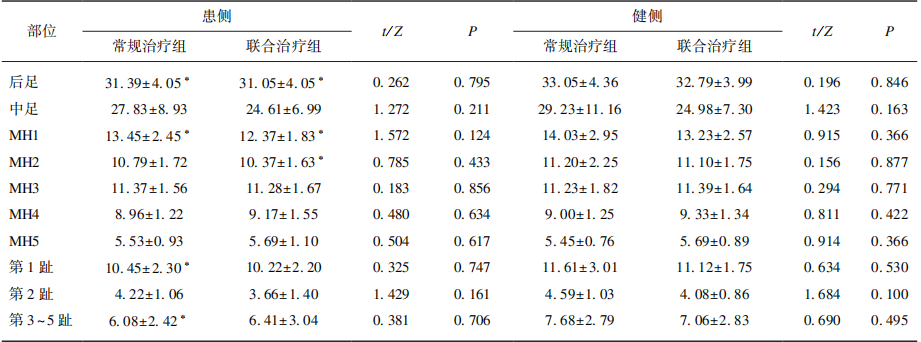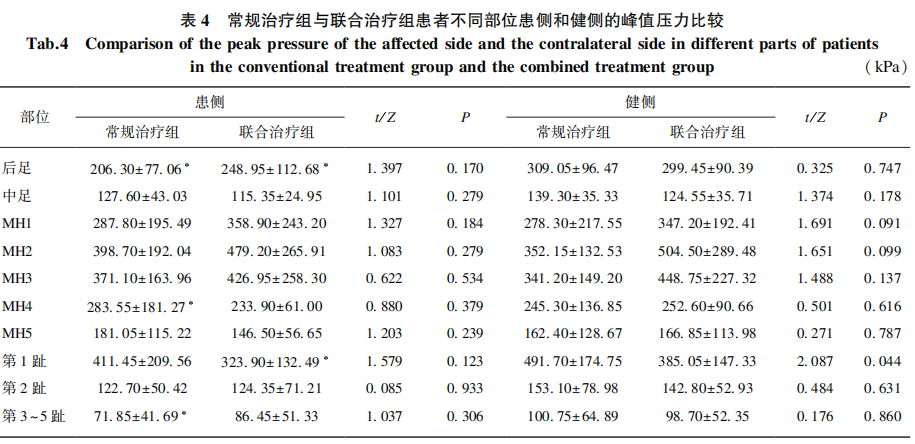Effect of plantar pressure on postoperative patients
Abstract:
To explore the effect of anti-gravity treadmill walking training on plantar pressure in patients with meniscus injury after surgery. Methods Forty patients with meniscus injury after surgery were recruited and divided into a conventional treatment group and a combined treatment group according to the random number table method, with 20 cases in each group. The conventional treatment group received conventional rehabilitation treatment, while the combined treatment group added anti-gravity treadmill walking training on the basis of conventional rehabilitation treatment. After 4 weeks of treatment, the changes of Lysholm scores before and after treatment were observed in the two groups. The EMED plantar pressure analysis equipment was used to analyze and compare the plantar pressure-related indicators (maximum force, peak pressure, and contact area) of the two groups of subjects.
The article is cited in:
Effect of anti-gravity treadmill walking training on plantar pressure in patients with meniscus injury after surgery
Article link:https://tjyxxb.ijournals.cn/ch/reader/view_abstract.aspx file_no=20230112flag=1


Among sports injuries, knee meniscus injury is very common. Minimally invasive surgical techniques combined with postoperative rehabilitation therapy are important methods for restoring knee joint function. Conventional rehabilitation training uses joint loosening techniques, muscle stretching techniques, muscle strength training techniques, gait training and other methods for gradual and targeted treatment. However, for patients who cannot fully bear weight due to pain, swelling and other reasons, there is a lack of early gait training, which leads to abnormal gait in the later stage of patients, prolongs the rehabilitation time and reduces the rehabilitation efficiency. Anti-gravity treadmill provides a possibility for early weight loss walking training. Plantar pressure is an important parameter to characterize the motor function of the lower limbs. Its size distribution can reflect the structure, function and control of the whole body posture of the lower limbs. This study compared the differences in Lysholm scores and plantar pressure test results between the two groups of patients after conventional rehabilitation treatment and combined anti-gravity treadmill treatment, and explored the characteristics of gait changes in patients with knee meniscus injury after anti-gravity treadmill treatment, providing a basis for optimizing postoperative rehabilitation programs.
The 40 patients were evaluated for knee joint function by the same rehabilitation physician using the Lysholm score before and after this clinical study of rehabilitation treatment. The patients who completed the treatment underwent plantar pressure testing. The specific method was as follows: Using the EMED plantar pressure analysis device, the subjects in the conventional treatment group and the combined treatment group were asked to perform plantar pressure testing in a barefoot state. The subjects walked across the force platform using their daily walking posture and speed, with only one foot landing on the force platform each time, and repeated measurements were performed so that a complete plantar pressure map could be recorded each time. A total of 5 plantar pressure values for the right foot and the left foot were recorded. The test data was automatically collected by the system, and the average value of each test index was automatically calculated as the test report result. The maximum force, peak pressure and contact area of the subject’s foot during walking were selected and recorded as analysis indicators.
Conclusion:
In the comparison of peak pressure in this study, the peak pressure of the affected heel and the 3rd and 5th toes in the conventional treatment group decreased, and the peak pressure of MH4 increased; the peak pressure of the affected heel and the 1st toe in the combined treatment group decreased; the peak pressure of the 1st toe on the healthy side in the conventional treatment group was greater than that in the combined treatment group, indicating that after walking training on the anti-gravity treadmill, the patient’s gait was optimized, but there was still a gap with the normal gait. Lou Zhen performed plantar pressure testing on 20 patients after medial meniscus repair of the knee joint and found that the peak pressure of the M1 and M2 areas on the affected side decreased after the right meniscus injury surgery. Fu Haiyan et al. used the plantar pressure testing system to analyze 40 patients with knee osteoarthritis and found that the peak pressure of the affected heel area was lower than that of the normal youth group, which was related to the poor muscle activity and balance control of the patient’s heel lateral side. Some studies have shown that the decrease in peak pressure may be caused by a decrease in muscle strength.
Although both groups of subjects in this study underwent systematic strength training, due to limited training time and the need for training intensity to be within the pain tolerance range, the muscle strength on the affected side could not meet normal needs, so the peak pressure still decreased after rehabilitation training.